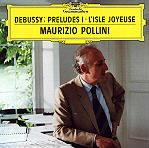Maurizio Pollini’s main qualities as an artist are neither humor nor abundance of keyboard color. Now, these happen to be among the requisites necessary to play Debussy’s Preludes in the right frame of mind (let’s not speak about that woolly notion called “style”). How do these jewels take to Pollini’s austere and serious approach? Well, better than you might expect. The Italian pianist’s full-bodied sound gives them a strong physical impact, miles away from the foggy sonorities that many pianists still use (and abuse) in Debussy. Here, lines are crisp and clear, contrasts dramatic, and rhythms turbulent. If this sharp-edged pianism doesn’t fully evoke the myriad perfumes, radiant colors, shades, and subtleties concealed in the music, at least it’s got some flesh and bones instead of smoke and clouds. With Pollini, the Preludes sound ahead of their time, not like some decadent addendum to the previous century. But his is still a partial approach that downplays some of the music’s peculiarities. In terms of unbridled imagination and ecstatic beauty of sound, no living pianist comes even close to Samson François’ visionary recording for EMI. Just compare him with the newcomer in La sérénade interrompue: while Pollini sticks to an extreme severity of tone and an almost metronomic tempo, François gives a lesson in flexibility, underlined by a refined use of rubato that reveals the very essence of the piece, its “modernity” as well as its nostalgic mood. Pollini grasps L’Isle joyeuse with such furious energy that you wonder if there is anything joyous about it at all. On the other hand, his restless treatment gives this descriptive tone poem an epic, haunting dimension that’s hard to forget. Not the greatest, then, but pianism that’s equally impossible to dismiss. At 43 minutes, there was plenty of room for more music.
































